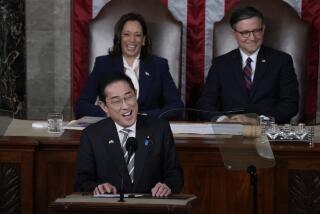The Japan That Doesn’t Know What to Say
- Share via
CAMBRIDGE, MASS. — Ihe late 1980s, when Japanese elites were feeling particularly rich and technologically muscle-bound, Sony Chairman Akio Morita joined forces with nationalist politician Shintaro Ishihara in a widely discussed book, “The Japan That Can Say ‘No’ .” An unauthorized translation circulated samizdat-like throughout U.S. government, business and academic circles.
The authors told their compatriots that they were weary of being pushed around on trade and policy issues. Japan had grown up and should shed its role as compliant junior partner to a United States that, in decline and beset by troubles of its own making, had gone from great power to moralistic bully. Japan could play a Soviet card. It could deny technology to the United States. At last, it could “just say no.”
Instead, during the Gulf War crisis of 1990-1991--the first real test of this perspective--Japan said “yes,” albeit sotto voce. After a wrenching and protracted domestic debate, it decided it could not be left alone. The Japanese government reluctantly agreed to underwrite President George Bush’s Gulf War coalition, to the tune of $13 billion. It also took the first small steps toward enabling the Japanese military to participate in U.N.-sanctioned peacekeeping activities.
Soon after, my students and I organized the first of three biannual Asia Pacific Crisis Simulations, which analyzed Japan’s post-Cold War international role in light of plausible domestic, regional and global changes. Attention was always paid to the foreign-policy choices and domestic political dynamics in China, the United States and other neighboring states.
The game’s players were assembled from around the world and assigned to teams representing constituencies and leaders in Japan, the United States, China, Korea, Indonesia, Taiwan, Vietnam, Malaysia and Australia. Through role-playing and negotiations, under the fictional pressure of international crisis and conflict, each team developed national plans and policies over the course of three four-year “moves.” The game starts 10 years from the present. Action is fast and furious. Deals are cut and reneged upon; betrayal and cooperation vie for prominence. Crises once thought resolved return to frustrate diplomats. Participants feel the pressure and stakes of world politics.
But watching Japanese reactions to these games teaches us as much as do the games themselves. Each time, the central lesson concerns the underdevelopment of public debate on Japanese security. Summit pronouncements and platitudes about the U.S. alliance notwithstanding, Japan still seems not to know what it wants to say about its national security.
The first game, held in May 1993, investigated the dynamics and outcomes of an all-out U.S.-Japan trade war. When Europe and a democratic Russia emerged from global financial and monetary crises richer, stronger and consolidated, we learned an important lesson of how much the United States and Japan had to lose from a trade war. But the Japanese press took away a different lesson. One major magazine ran a feature story about how the Massachusetts Institute of Technology, the site and organizer of the game, was the tool of the Pentagon.
Troubled by Japanese misunderstanding of the purposes and lessons from this exercise, I decided to secure Japanese funding and to play the game in full view of the Japanese public the second time around. The second game, held in May 1995, explored how Japan might react in regional crises if the United States declared itself unwilling to intervene on Japan’s behalf.
Two crises were conceived, one involving huge flows of Korean refugees to Japan after a bumpy Korean unification, the other a hostage crisis in Southeast Asia. Despite considerable domestic political instability, the Japanese team succeeded in achieving many of its long-term objectives, including a resolution to trade disputes with the United States, revision of its anti-war Constitution and reaffirmation of U.S. security guarantees. To the surprise of many, the refugee problem was swiftly resolved. The rise of a hostile Islamic republic in Southeast Asia, on the other hand, led to military activity and the disruption of trade in the Malacca Strait. This time, the Japanese press’ reaction was overwhelmingly positive. But the television show based on the game was broadcast between 1 a.m. and 4 a.m. in Japan.
When the time came to secure funding for this year’ exercise, we were told that Japanese think tanks were working on their own simulations, and that inclusion in our game of any one of a half-dozen most likely regional conflicts would be too touchy for a Japanese sponsor to support. So we ran the game without outside support. Again we invited Japanese, Chinese and other regional experts. We sought to test the dynamics of a northeast Asian region in which China, Japan and the United States no longer had any mutual obligations, but one in which mutual mistrust was rife. We observed a fluid pattern of alliance formation, one in which the balancing of power overwhelmed historical animus.
The Japanese reaction has been stunning. The day after the game, the Mainichi Shimbun ran a front-page story about how MIT fantasized an “isolated” Japan in the early 21st century. The story ended by noting correctly that our 1995 simulation presaged with eerie accuracy the takeover of the Japanese ambassador’s residence in Lima, Peru. My office was deluged with calls from the Japanese Embassy in Washington and from the consulate-general in Boston seeking background information and data on the game. The governor of Okinawa sent his U.S. representative to Cambridge to meet me. A major Japanese publisher asked a leading Japanese television personality to contact me to secure the rights for a co-authored account of the game. Apparently, the game has worked its way into parliamentary debate in Japan.
It is good that Japan is engaged in this long-overdue public discussion. After all, it spends more on its military than all but two nations in the world. Despite its cultivated image as an unarmed small-island trading nation, it is already a very strong regional actor. Japan has the most powerful air force in Asia and the second largest blue-water navy.
Thus, it is especially disquieting that the Japanese media and government have so much trouble assessing the relative importance of an educational exercise at a U.S. university against the much larger importance of substantive debate about foreign- and security-policy options in the real world. Ironically, the greatest lesson from our simulations did not emerge from the fictional crises we created and tried to resolve. It has come from observing the widely oscillating reactions back in Japan to what academics in the United States are studying. The Japanese people, their neighbors and their U.S. allies will be very fortunate indeed if Japanese security policy is not tested until Japan decides what it really wants to say.
More to Read
The biggest entertainment stories
Get our big stories about Hollywood, film, television, music, arts, culture and more right in your inbox as soon as they publish.
You may occasionally receive promotional content from the Los Angeles Times.










